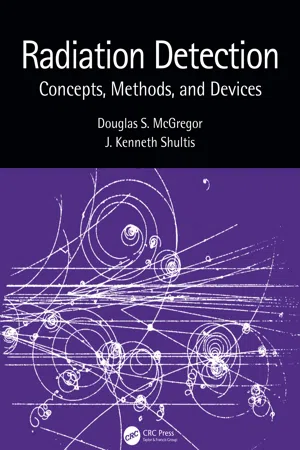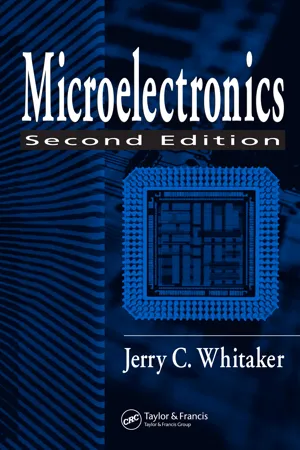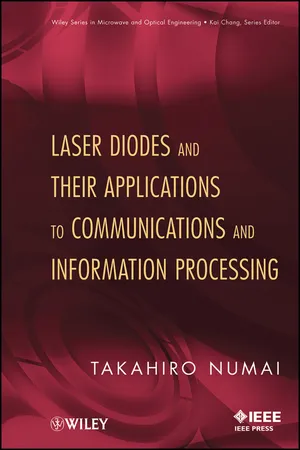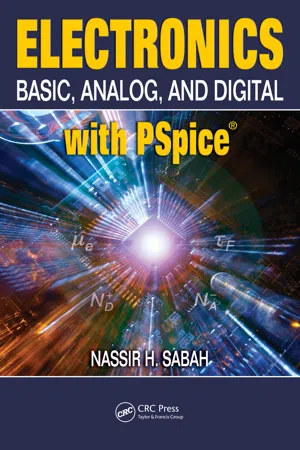Effective Mass
Effective mass refers to the mass of a particle in a solid-state material, which can differ from its actual mass due to interactions with its surroundings. In semiconductors and other materials, the effective mass is used to describe the behavior of charge carriers such as electrons and holes. It is a crucial parameter for understanding the electrical and thermal properties of materials.
4 Key excerpts on "Effective Mass"
- eBook - ePub
Radiation Detection
Concepts, Methods, and Devices
- Douglas McGregor, J. Kenneth Shultis(Authors)
- 2020(Publication Date)
- CRC Press(Publisher)
...12.21. The importance of the effective-mass concept is that those electrons with positive Effective Masses flow in the direction of the applied electric field force, but those electrons with negative Effective Masses flow in the opposite direction of the applied force. Figure 12.20. The reduced zone diagram depicts energy bands in one dimension. The bands may be completely filled, partially filled, or void of electrons. Figure 12.21. A force applied to the periodic structure, such as electric field force, displaces the electron in k -space, thereby perturbing the equilibrium condition. To determine the current, the total motion of electrons in all of the bands must be taken into consideration [Pierret 1989]. Electric current from contributions in the lower conduction band can be written as I c = − q d ∑ filled i v i, (12.53) where the speed contributions from only those states in the conduction band filled with electrons are considered, and d is the width of the semiconductor block between the two contacts. Next, the current contributions from the valence band are found as I v = − q d ∑ filled i v i, (12.54) where, again, the speed contributions from only those states in the valence band filled with electrons are used. The summation of currents for the valence band can be difficult because the electrons have both positive and negative Effective Mass. As a result, positive and negative velocities must also be taken into account. This situation can be greatly simplified by introducing a few approximations. First, note that electrons in the conduction band congregate at the bottom of the band, as occurs in semiconductors operating at ambient temperatures. It can also be assumed that all of the electrons have positive Effective Mass. To simplify further, it is apparent from Fig. 12.19 that the Effective Mass, inversely proportional to d 2 E / dk 2, is fairly constant near the top and bottom of the energy bands...
- eBook - ePub
- Jerry C. Whitaker(Author)
- 2018(Publication Date)
- CRC Press(Publisher)
...The effective scalar mass in this case is m * = (m h 3 / 2 + m l 3 / 2) 2 / 3. Such light and heavy holes occur in several semiconductors, including Si. Values of Effective Mass are given in Tables 1.8 and 1.5. Intrinsic Carrier Densities The density of free electrons in the conduction band depends on two functions. One is the density of states D (E) in which electrons can exist and the other is the energy distribution function F (E, T) of free electrons. The energy distribution function (under thermal equilibrium conditions) is given by the Fermi-Dirac distribution function F (E) = [ 1 + exp (E − E f k B T) ] − 1 which, in most practical cases, can be approximated by the classical Maxwell-Boltzmann distribution. These distribution functions are general functions, not dependent on the specific semiconductor material. The density of states D (E), on the other hand, depends on the semiconductor material. A common approximation is D n (E) = M c 2 π 2 (E − E c) 1 / 2 ℏ 3 (m e *) 3 2 for electrons and D p (E) = M v 2 π 2 (E v − E) 1 / 2 ℏ 3 (m h *) 3 2 for holes. Here, M c and M v are the number of equivalent minima in the conduction band and valence band, respectively. Note that, necessarily, E ≥ E c for free electrons and E ≤ E v for free holes due to the forbidden region between E c and E v. The density n of electrons in the conduction band can be calculated as n = ∫ E = E c ∞ F (E, T) D (E) d E For Fermi levels significantly (more than a few k B T) below E c and above E v, this integration leads to the. results n = N c e − (E c − E f) / k b T and p = N v e − (E f − E v) / k b T where n and p are the densities of free electrons in the conduction band and of holes in the valence band, respectively. N c and N v are effective densities of states that vary with temperature (slower than the exponential in the preceding equations), Effective Mass, and other conditions. Table 1.6 gives values of N c and N v for several semiconductors...
- Takahiro Numai(Author)
- 2011(Publication Date)
- Wiley-IEEE Press(Publisher)
...In general, the Effective Mass of the conduction electron has different values according to the direction of the wave vectors. When the Effective Masses of a conduction electron along the principal axes of wave vectors are expressed as m 1 *, m 2 *, and m 3 *, the density-of-states Effective Mass of the conduction electron m e is given by (5.4) In Si and Ge, by using the transverse Effective Mass m t and the longitudinal Effective Mass m l, the density-of-states Effective Mass m e is written (5.5) where (5.6) Hole Concentration The hole concentration p is given by (5.7) Here E v is the energy of the top of a valence band and g (E v − E) is the density of states per unit volume for the valence band. N v is the effective density of states for the valence band, which is defined as (5.8) Here, by using the Effective Mass of the heavy. hole m hh and the Effective Mass of the light hole m lh, the Effective Mass of the hole m h is expressed as (5.9) where m dh is called the density-of-states Effective Mass for the valence band. Intrinsic Carrier Concentration The carrier concentration in the intrinsic semiconductor, that is, the intrinsic carrier concentration n i, has a relation such as (5.10) Using the energy gap E g = E c − E v, we have (5.11) As a result, the intrinsic carrier concentration n i is written (5.12) In thermal equilibrium, both the intrinsic and extrinsic semiconductors satisfy (5.11) and (5.12). Intrinsic Fermi Level From (5.2), (5.7), and (5.10), the intrinsic carrier concentration n i is given. by (5.31) where E i is the Fermi level in the intrinsic semiconductor, that is, the intrinsic Fermi level...
- eBook - ePub
Electronics
Basic, Analog, and Digital with PSpice
- Nassir H. Sabah(Author)
- 2017(Publication Date)
- CRC Press(Publisher)
...It is important, therefore, to consider aspects such as carrier concentrations, mobility, and lifetime. Learning Objectives ❖ To be familiar with: • Some of the basic ideas of wave mechanics. ❖ To understand: • The basis for the energy band structure of semiconductors. • The basis for tunneling. • The concept of Effective Mass and the basis for hole conduction. • The concept of electrochemical potential and its implications for semiconductors at equilibrium and under bias. • How carrier concentrations in a semiconductor can be determined. • The factors affecting carrier mobility and lifetime. 2.1 Excerpts from Wave Mechanics Some Basic Ideas Quantum theory, or quantum mechanics, provides the most rigorous and powerful tool available for investigating physical phenomena. A particular formulation of quantum theory, wave mechanics, is customarily used to analyze electric conduction in crystals. It is well beyond the scope of this chapter to go beyond a brief and sketchy introduction to concepts needed for gaining some understanding of the electrical behavior of semiconductors. Concept: Radiant energy, like matter, is quantized. In other words, energy in the form of radiation is not emitted or absorbed continuously but in discrete packets. Each packet is a quantum having energy E q given by: E q = h ν (2.1.1) where h is Planck’s constant (6.626 × 10 −34 Js) v is the frequency of the radiation In the case of ultraviolet light of v = 3 × 10 15 Hz, for example, E q ≅ 2 × 10 −18 J, which is exceedingly small. A quantum of electromagnetic radiation is a photon. According to the Special Theory of Relativity, energy and mass are equivalent in accordance with Einstein’s famous relation E = mc 2, where c is the speed of light in vacuum. Hence, a photon of energy E q = hv has an equivalent mass hv/c 2...



